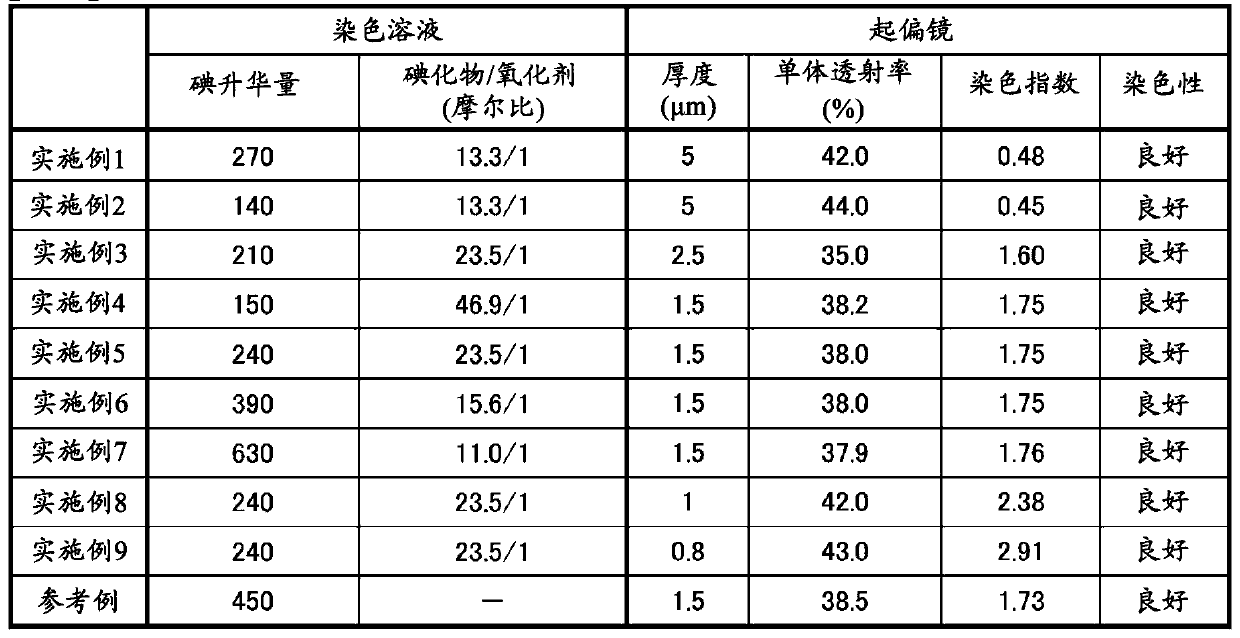Polarizer production method
A manufacturing method and technology for polarizers, which are applied in polarizing elements, instruments, optical elements, etc., can solve the problems of iodine environment and adverse effects on human body, and achieve the effects of preventing adverse effects, efficient dyeing, and increasing content
- Summary
- Abstract
- Description
- Claims
- Application Information
AI Technical Summary
Problems solved by technology
Method used
Image
Examples
Embodiment 1
[0056] As a thermoplastic resin substrate, an amorphous isophthalic acid-copolymerized polyethylene terephthalate (IPA-copolymerized PET) film (thickness: 100 μm) having a water absorption rate of 0.75% and a Tg of 75° C. was used. Corona treatment is performed on one side of the substrate, and the corona-treated surface is coated with polyvinyl alcohol (polymerization degree 4200, saponification degree 99.2 mol%) and acetoacetyl modified at a ratio of 9:1 at 25°C. PVA (polymerization degree 1200, acetoacetyl group modification degree 4.6%, saponification degree 99.0 mol% or more, Nippon Synthetic Chemical Industry Co., Ltd., trade name "GOHSEFIMER Z200") aqueous solution and drying to form a PVA-based resin layer with a thickness of 11 μm , thereby producing a laminate.
[0057] The obtained laminate was uniaxially stretched 2.0 times toward the free end in the longitudinal direction (long side direction) between rolls having different circumferential speeds in an oven at 120...
Embodiment 2
[0065] Except that the dyeing solution is an aqueous solution (the molar ratio of iodide and oxidizing agent in the dyeing solution=13.3 / 1) to 100 parts by weight of water, 1.7 parts by weight of potassium iodide and 0.4 parts by weight of ferric sulfate n-hydrate added, and A laminate 2 having a PVA-based resin layer (polarizer) with a thickness of 5 μm was produced in the same manner as in Example 1.
Embodiment 3
[0067] A laminate was produced in the same manner as in Example 1.
[0068]The obtained elongated laminate was stretched 4.5 times in an air atmosphere at 140° C. in a direction perpendicular to the longitudinal direction of the laminate using a tenter stretching machine.
[0069] Next, the laminate was dipped in a 30° C. dyeing solution (an aqueous solution to which 6.0 parts by weight of potassium iodide and 0.8 parts by weight of iron sulfate n-hydrate were added to 100 parts by weight of water) for 30 seconds to perform dyeing (dyeing treatment). The molar ratio of iodide to oxidant in the staining solution is 23.5 / 1.
[0070] Next, it was immersed in a crosslinking bath (a boric acid aqueous solution obtained by blending 3 parts by weight of potassium iodide and 3 parts by weight of boric acid with respect to 100 parts by weight of water) at a liquid temperature of 60°C for 35 seconds (crosslinking treatment). ).
[0071] Next, the laminate was immersed in a cleaning ba...
PUM
| Property | Measurement | Unit |
|---|---|---|
| electric potential / voltage | aaaaa | aaaaa |
| thickness | aaaaa | aaaaa |
| thickness | aaaaa | aaaaa |
Abstract
Description
Claims
Application Information
 Login to View More
Login to View More - R&D
- Intellectual Property
- Life Sciences
- Materials
- Tech Scout
- Unparalleled Data Quality
- Higher Quality Content
- 60% Fewer Hallucinations
Browse by: Latest US Patents, China's latest patents, Technical Efficacy Thesaurus, Application Domain, Technology Topic, Popular Technical Reports.
© 2025 PatSnap. All rights reserved.Legal|Privacy policy|Modern Slavery Act Transparency Statement|Sitemap|About US| Contact US: help@patsnap.com


